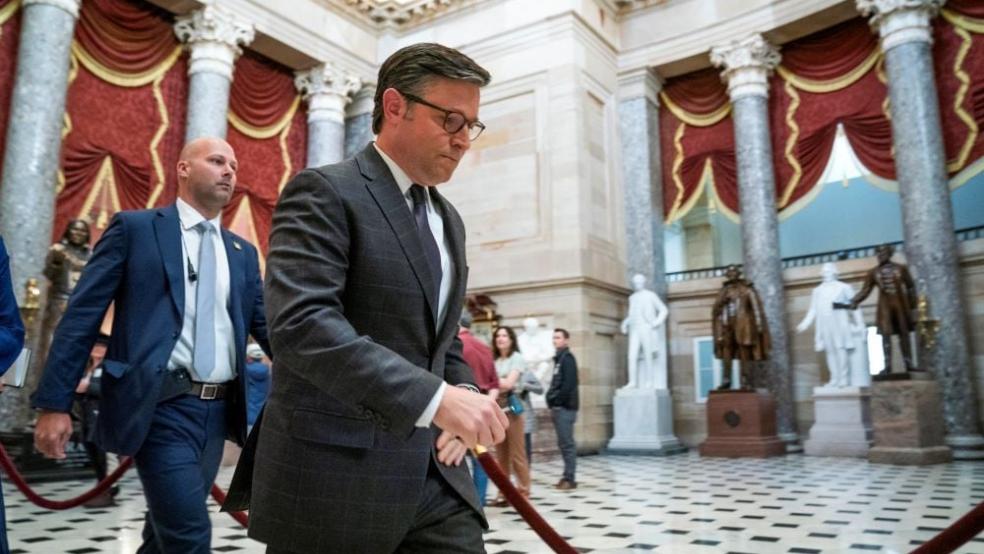The House Rules Committee is set to vote tonight on a stopgap extension of federal funding that would prevent a government shutdown starting Saturday — the first big test for the unconventional, two-tiered plan put forth Speaker Mike Johnson.
An even bigger test could follow, as Johnson reportedly may have to rely heavily on Democratic votes and parliamentary maneuvering to pass his plan in the face of growing conservative opposition.
A clean, laddered CR: Johnson on Saturday proposed a plan that some lawmakers had previously warned would be overly complicated. His 32-page continuing resolution adopts a two-step approach favored by the House Freedom Caucus and is meant to ensure that lawmakers focus on individual appropriations bills rather than a mammoth year-end package that rolls up multiple pieces of spending legislation.
The bill would fund some federal agencies — those covered by the Military Construction-VA, Agriculture, Energy-Water and Transportation-HUD spending bills — until January 19 and keep agencies covered by the other eight annual spending bills funded to February 2. But the plan also would keep spending at current levels, without the steep cuts or additional border policies demanded by hard-right Republicans. And the legislation leaves out the supplemental funding requested by the White House, including emergency aid for Ukraine and Israel.
“The bill will stop the absurd holiday-season omnibus tradition of massive, loaded up spending bills introduced right before the Christmas recess,” Johnson said in a statement. “Separating out the CR from the supplemental funding debates places our conference in the best position to fight for fiscal responsibility, oversight over Ukraine aid, and meaningful policy changes at our Southern border.”
The proposal was reportedly formulated after the speaker spent his first couple of weeks on the job listening to the various factions within his splintered conference — and received conflicting feedback on the path forward. In the end, he picked an approach that The Washington Post’s Marianna Sotomayor and Leigh Ann Caldwell write was “meant to appease the hard right while trying not to alienate the centrists.”
Some on the far right rejected it quickly, though. At least eight Republicans have reportedly come out against it already, including Rep. Scott Perry, the chairman of the House Freedom Caucus, and Rep. Chip Roy of Texas.
That means the bill will need Democratic support to advance to the Senate and reach President Joe Biden’s desk — and Democrats thus far have sent some mixed messages, but they may be willing to provide enough support to pass the plan.
* Senate Majority Leader Chuck Schumer said Monday he is “pleased” with the Johnson plan, though he also called it “far from perfect” in remarks on the Senate floor. “For now, I am pleased that Speaker Johnson seems to be moving in our direction by advancing a CR that doesn’t include the highly partisan cuts that Democrats have warned against,” Schumer said. He added that it was important that the defense funding deadline was in the February group. “Democrats historically fear that Republicans would be willing to shut down the entire government if defense funding is complete,” The Washington Post notes. “This proposal keeps defense funding on the table to provide incentive to fund the rest of the government.”
* House Democratic leaders said in a letter to colleagues that they are “carefully evaluating” the Johnson plan and discussing it with their members, adding that they are concerned about the multiple deadlines and the lack of supplemental funding provisions.
* The White House on Saturday called the bill unserious and a waste of time. “This proposal is just a recipe for more Republican chaos and more shutdowns—full stop,” Press Secretary Karine Jean-Pierre said in a statement. “House Republicans need to stop wasting time on their own political divisions, do their jobs, and work in a bipartisan way to prevent a shutdown.” But Biden on Monday held off on saying whether he would sign the bill or veto it. "I'm not going to make a judgment on whether I'd veto or I'd sign,” he told reporters. “Let's wait and see what they come up with.”
The bottom line: The House Rules Committee vote sets up a vote on the House floor as soon as Tuesday. If Johnson can steer his bill through to passage, it may have a good shot of getting through the Senate as well. Neither side wants a pre-Thanksgiving shutdown.
“If he can’t get the two-step plan through both chambers, Johnson plans to offer up a full-year CR with increases only for defense and national security priorities,” Roll Call reported over the weekend, citing talking points circulated to House Republicans. That approach, which would slash non-defense programs by about 8%, might not be able to pass the House and would go nowhere in the Senate, likely leading to a showdown.





